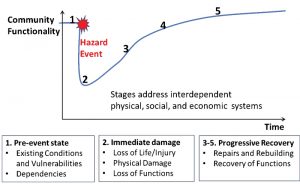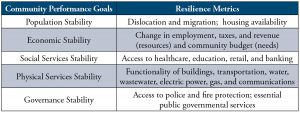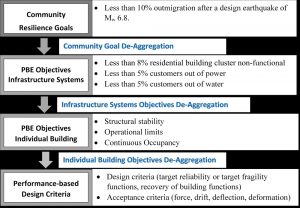Despite the progress that has been made in disaster-related science and technology and the significant financial investments made at the federal, state, and local levels in risk mitigation, The National Academies continue to view community resilience as a national imperative. Events such as Hurricane Katrina in 2005, the Christchurch earthquake and Joplin tornado in 2011, and Superstorm Sandy in 2012 highlighted the need to better understand community resilience to mitigate the risks associated with severe natural hazards.
Investigations of recent disasters have revealed the importance of resilience planning for integrated community performance and functionality following disruptive hazard events, including response and recovery, rather than merely addressing public safety and the “sunny day” functionality of utilities. Resilience is defined as the ability to prepare for and adapt to changing conditions and withstand and recover rapidly from disruptions caused by natural and man-made hazards. The spectrum of resilience modeling and assessment requirements for community physical, social, and economic systems is summarized in Figure 1.
Codes, Standards, and Building Regulations
The performance of civil infrastructure, which is essential to community resilience, is, first and foremost, the responsibility of structural and civil engineers. Codes and standards largely determine the performance of civil infrastructure (e.g., International Building Code, ASCE Standard 7, AASHTO Bridge Design Specification). These codes and standards for buildings and bridges apply to individual facilities. They are focused on life safety goals because of the nature of the building regulatory process. Except for structural systems assigned to ASCE 7
Risk Category IV, the role of individual buildings in fulfilling community resilience goals seldom is recognized by codes. Nor is there any consideration of structural repairs or functional recovery when evaluating design options.
Codes, standards, and building regulations in the U.S. have been developed by different professional organizations and agencies, with variable performance objectives for life safety relating to hazard events, service periods, reliability, and recovery of function. A critical aspect of community resilience – a community’s social needs and objectives, especially concerning post-disaster recovery – is not reflected in codes and standards and other regulatory documents that are used to design individual facilities.
Achieving Community Resilience
A community is defined as a place (such as towns, cities, or counties) designated by geographic boundaries that functions under a governance structure for decision making. A community has a built environment and social and economic systems to provide essential community needs, such as shelter, transportation, power, potable water, sanitation, employment, commerce, education, healthcare, and government.
Community resilience addresses the ability of a community’s buildings and infrastructure systems to deliver these essential community needs reliably and at a reasonable cost, both before and within a specified timeframe after a damaging event. The integrity of the built environment is central to the resilience of a community’s infrastructure and social and economic institutions. Still, there is currently no common technical basis for linking community-level performance goals with performance objectives of codes and standards for the design of individual buildings, bridges, and lifeline systems.
Measuring Community Resilience
A new, interdisciplinary approach is required to achieve community resilience goals, one that addresses the interdependencies among the physical, social, and economic systems on which a healthy and vibrant community depends. The Center of Excellence for Risk-Based Community Resilience Planning (the Center), headquartered at Colorado State University and involving 13 partner universities, was established by the National Institute of Standards and Technology (NIST) in 2015 to advance measurement science for community resilience. This includes identifying key resilience factors and metrics, assessing the likely impact of natural hazards on community functions, and providing decision support through risk-informed options with optimal strategies for improving resilience.
Community-level performance goals are often stated as long-term aspirations for the functionality of physical, social, and economic systems. Designers need quantitative performance objectives and design criteria for the evaluation of individual facilities and systems that can support community goals., The collective performance of infrastructure systems and facilities must be quantified using metrics related to functionality and recovery to link the response to community resilience goals. The development of community metrics is a critical aspect of the cooperative partnership between NIST and the Center for addressing community resilience on a national scale. The Table gives a few examples of community performance goals and associated resilience metrics being used by the Center.
A Computational Toolbox
One of the Center’s significant accomplishments in its first five years has been the development of a modular, open-source computational environment, IN-CORE – Interdependent Networked Community Resilience Modeling Environment. IN-CORE allows researchers, engineers, and community planners to simulate the impacts of natural hazard events on communities and the recovery of community-wide functions to evaluate and optimize alternative resilience enhancement strategies in support of community planning.
IN-CORE is a multidisciplinary computational environment, with supporting databases, which models community systems through a set of modules and algorithms. IN-CORE is structured so that users can utilize core modules or include their own analysis modules, depending on their needs. The core IN-CORE algorithms for modeling interdependent physical, social, and economic systems, that are included in the initial release, include:
- The hazard module includes algorithms for earthquakes, synoptic windstorms, tornadoes, hurricanes, wildfires, tsunamis, and floods.
- The physical infrastructure module includes buildings, transportation, water, energy, and telecommunication systems. Fragilities (for discrete elements) and repair rates (for line elements within networks) predict the physical damage, potential repair rates, and recovery times for a given hazard scenario.
- The social and economic modules currently predict population dislocation, housing repair and recovery, and business interruption and recovery. Changes in the local economy and demographics are based on post-event functionality of the physical infrastructure of the community and a computable equilibrium model of its economy.
The initial (December 2019) release is available at https://bit.ly/2UllQBe or https://bit.ly/3h9hV3V and has example case studies for communities subject to an earthquake, tsunami, and tornado events. Technical support and user manuals are available, as well as the opportunity to join user groups.
Additional releases will be made as features are developed. Future IN-CORE releases will include a recovery module to capture the process of community recovery to a specified state of functionality. Also included will be a decision/optimization module, which will use selected characteristics of physical, social, and economic infrastructure systems to identify optimized strategies for pre-hazard mitigation and post-hazard recovery.
The Role of Structural Engineering
Structural engineers and structural engineering technology have a significant role in improving the resilience of a community to natural hazards because the performance of the built environment is central to the welfare of any community. Public safety aspects (such as stability and life safety) are addressed by either conventional building codes or through novel performance-based engineering (PBE) approaches. In contrast to building code approaches, PBE can enable risk-informed design and decision-making for innovative structures with performance objectives beyond code requirements.
In current PBE of buildings, the performance objectives are established for occupant needs and/or building functions (e.g., data centers, specialty manufacturers, hospitals). The role that buildings play in the resilience of the community seldom is considered. Many aspects of resilience, including loss of functionality and recovery, require more comprehensive and standardized assessment methods.
To advance the current state of practice, the structural design process should start with individualized community-level goals to inform performance objectives for individual projects, including recovery-based performance objectives. Community performance goals and metrics must be de-aggregated to the individual facility level. Then, goals and metrics can be used to develop risk-informed design standards and guidelines, code approaches, or PBE criteria that can be used by structural engineers and other design professionals. This process is illustrated in Figure 2.
A Path Forward
Best practices of design professionals and decisions by city planners and regulatory authorities are likely to evolve in the coming decade to support community resilience. However, buildings, bridges, and other civil infrastructure facilities will probably continue to be designed on an individual rather than a community basis.
PBE provides a path forward for addressing this conflict and resolving the inherent challenges that will arise in solving both facility and community needs. These challenges will likely require a fundamental change in the way that code- and standard-writing groups approach their tasks to achieve shared community resilience goals. A few of these challenges for structural engineers include:
- A broadly based stakeholder group should identify common community resilience goals; traditional performance measures are not sufficient to ensure community resilience.
- Methodologies are needed to guide the development of community resilience goals and metrics and to derive performance objectives and design criteria for individual projects. Otherwise, there will be no consistent basis for national or regional building practices because resilience goals and metrics for each community are unique.
- Performance objectives for buildings by functional categories or groupings (e.g., residential buildings, commercial facilities, government) or socioeconomic institutions (e.g., education, health care) should be expressed as requirements that are compatible with engineering practice and practical to implement from an engineering perspective.
- PBE to support community resilience must acknowledge the reality of the U.S. building regulatory process, which is likely to change slowly.
- Reliability targets for individual buildings in current structural design practices (e.g., ASCE 7-16 Section 1.3) set minimum performance requirements at the component level for most design loads except earthquake loads. Target reliability and performance criteria at the system level for all loads are needed to support community resilience goals.
- Codes, standards, and regulations for infrastructure systems (e.g., buildings, bridges, lifelines) should be coordinated to support community resilience goals and to address the functionality and recovery of civil infrastructure as well as life safety.
- Planning and development of major projects will be increasingly performed by interdisciplinary teams, which must be able to communicate aspirations, goals, metrics, and risks to one another. This shift will require changes in university education, especially in civil engineering, to ensure that these teams can effectively work together.
Conclusions
The structural engineering profession has a central role to play in enhancing community resilience because the built environment is fundamental to a resilient community. The Center recently has been renewed for 2020-2025, with a focus on community engagement and risk-informed decision-making with the ultimate goal of informing the development of efficient decision support algorithms that are useful and useable for community resilience planning. Future releases of IN-CORE are planned at approximately 6-month intervals with a critical focus on supporting decisions and implementation, as the Center continues to advance the science of community resilience.
The structural engineering community is invited to participate in this exciting new endeavor by exploring the Center webpages for information at http://resilience.colostate.edu.■
Acknowledgment
Funding for this study was provided as part of Cooperative Agreement 70NANB15H044 (2015-2020) and 70NANB20H008 (2020-Present) between the National Institute of Standards and Technology (NIST) and Colorado State University. The authors acknowledge the numerous researchers and students working on behalf of the Center; a full listing can be found at the above website. The content expressed in this article are the views of the authors and do not necessarily represent the opinions or views of NIST or the U.S Department of Commerce.
References
ASCE (2016). Minimum design loads for buildings and other structures (ASCE Standard 7-16). American Society of Civil Engineers, Reston, VA.
Attary, N., J.W. van de Lindt, H. Mahmoud, and S. Smith. 2018.. Hindcasting Community Level Damage for the Joplin MO 2011 EF5 Tornado: Buildings-Electric Power Network. ASCE Natural Hazards Review 20(1): 04018027 [DOI: 10.1061/(ASCE)NH.1527-6996.0000317].
Burton, H., Deierlein, G., Lallemant, D. and Lin, T. (2015). Framework for incorporating probabilistic building performance in the assessment of community seismic resilience.” Journal of Structural Engineering, ASCE 142(8): dx.doi.org/10.1061/(ASCE)ST.1943-541X.0001321.
Cutter, S. L., Burton, C. G., & Emrich, C. T. (2010). Disaster resilience indictor for benchmarking baseline conditions. Journal of Homeland Security and Emergency Management, 7. Article 51, 1–22.
Ellingwood, B.R., van de Lindt, J.W. and McAllister, T.P. (2016). Developing measurement science for community resilience assessment. Sustainable and Resilient Infrastructure 1(3-4):93.
Ellingwood, B.R., Cutler, H., Gardoni, P., Peacock, W.G., van de Lindt, J.W. and Wang, N. 2016. The Centerville virtual community: a fully integrated decision model of interacting physical and social infrastructure systems. Sustainable and Resilient Infrastructure 1(3-4): 95-107.
Ellingwood, B.R., Wang, N., Harris, J.R. and McAllister, T.P. 2019. The role of performance-based engineering in achieving community resilience. Ch. 6 in Handbook of Sustainable and Resilient Infrastructure, Routledge (ed. by P. Gardoni); 94-112. [ISBN 978-1-138-30687-5].
Goda, K. 2015. Seismic risk management of insurance portfolio using catastrophe bonds. Computer-Aided Civil and Infrastructure Engineering 30: 570-582.
IBC. 2018. International Building Code. International Code Council, www.iccsafe.org.
Koliou, M., J.W. van de Lindt, T.P. McAllister, B.R. Ellingwood, M. Dillard, and H. Cutler. (2018). “State of the Research in Community Resilience: Progress and Challenges.” Sustainable and Resilient Infrastructure, DOI:10.1080/23789689.2017.1418547.
Lin, P., Wang, N. and Ellingwood, B.R. (2016). A risk de-aggregation framework that relates community resilience goals to building performance objectives, Sustainable and Resilient Infrastructure, 1(1-2): 1-13.
Lounis, Z., and McAllister, T. P. 2016. Risk-based decision making for sustainable and resilient infrastructure systems. Journal of Structural Engineering, ASCE: F4016005.
McAllister, T. (2013). Developing guidelines and standards for disaster resilience of the built environment: A research needs assessment. NIST Technical Note 1795, National Institute of Standards and Technology, Gaithersburg, MD dx.doi.org/10.6028/NIST.TN.1795
McAllister, T. (2016). Research Needs for Developing a Risk-Informed Methodology for Community Resilience, Journal of Structural Engineering, ASCE 142(8): DOI: 10.1061/(ASCE)ST.1943-541X.0001379.
Mieler, M., Stojadinovic, B., Budnitz, R., and Mahin, S. (2015). A framework for linking community resilience goals to specific performance targets for the built environment. Earthquake Spectra, 31, 1267–1283.
Mileti, D. S. and Fitzpatrick, C. (1991). Communication of public risk: its theory and its application. Sociological Practice Review 2(1):20-28.
National Research Council. 2012. Disaster resilience: a national imperative. The National Academies Press, Washington, D.C. doi.org.10.17226/13457
NIST 2015. Community resilience planning guide for buildings and infrastructure systems (in two volumes). NIST Special Publication 1190 (Vols 1 and 2), National Institute of Standards and Technology, Gaithersburg, MD 20899.
Presidential Policy Directive 21 (PPD 21). 2013. Critical infrastructure security and resistance. The White House www.whitehouse.gov
van de Lindt, J.W., Peacock, W.G. and Mitrani-Reiser, J. (Eds.). (2018). Community resilience-focused technical investigation of the 2016 Lumberton, North Carolina Flood: multi-disciplinary approach. NIST Special Publication 1230, National Institute of Standards and Technology, Gaithersburg, MD 20899. doi.org/10.6028.NIST.SP.1230
Zhang, W., Lin, P., X. Xue, X., Wang, N. and C.D. Nicholson, C.D. 2017. Probabilistic Prediction of Post-disaster Functionality Loss of Community Building Inventories Considering Utility Disruptions. ASCE Journal of Structural Engineering, Vol 144 (4) doi.org/10.1061(ASCE)ST.1943-541X.0001984



